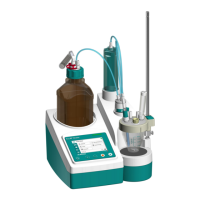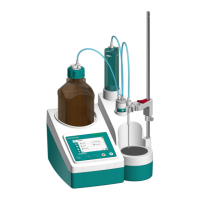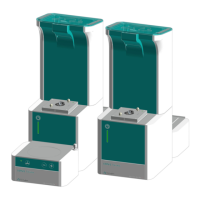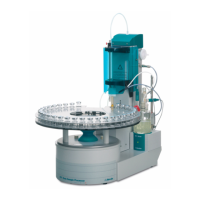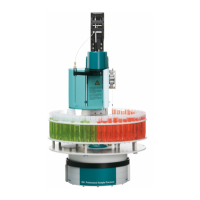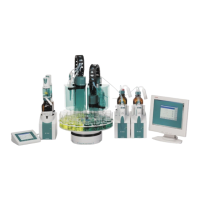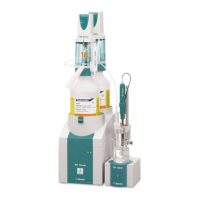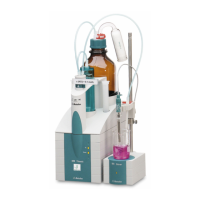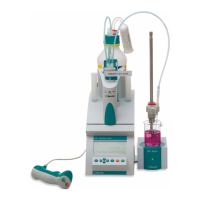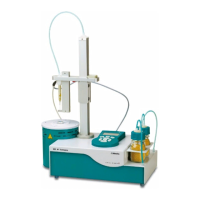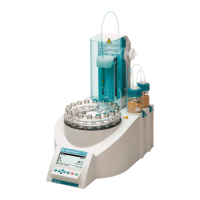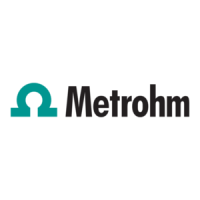Do you have a question about the Metrohm Eco Titrator and is the answer not in the manual?
Describes the Eco Titrator's functional units and supported titration modes.
Lists available versions of the Eco Titrator based on article number.
Explains formatting used in the documentation for clarity.
Guides users on how to find information about scope of delivery and accessories.
Defines the proper use of Metrohm products and warns against misuse.
Outlines the operator's duties for safe product handling and maintenance.
Specifies qualifications and knowledge required for personnel operating the product.
Provides warnings and safety measures for electrical, chemical, and flammable hazards.
Lists safety measures for transporting the product to prevent spills or injuries.
Explains the four hazard levels and signal words used in warning messages.
Illustrates and explains various warning signs according to ISO 7010.
Provides a general overview of the titrator's status display and interfaces.
Identifies key components of the Eco Titrator via a front view diagram.
Details the components of the dosing unit, including the cylinder unit and stopcock.
Identifies the components of the bottle unit, including the cannula and adsorber tube.
Details the functions of the magnetic stirrer and the dosing unit.
Describes the status display, status indicator, and control bar keys.
Provides a detailed list and explanation of all instrument interfaces and connectors.
Explains the pin assignment and inputs/outputs of the remote interface.
Details how to remotely control the instrument via Ethernet and the transfer protocol.
Explains the numerical format, rounding-off process, and statistics calculations.
Lists requirements for the optimal and safe setup location of the product.
Provides a warning about electrical shock and steps for preparing the instrument assembly.
Details the procedure for powering the instrument on and off, including a notice about unplugging.
Explains the initial assembly process using an installation wizard.
Describes the procedure for mounting the support rod, electrode holder, and clamping ring.
Guides through preparing the bottle cap with an adsorber tube.
Details how to connect the tubing from the bottle cap to the cylinder unit and buret tip.
Explains the importance of proper electrode positioning for effective stirring and measurement.
Details the procedure for powering the instrument on and off, including a notice about unplugging.
Guides users on setting the instrument's language, date, and time.
Explains how to set the dialog type (Expert/Routine) to restrict user access.
Identifies and describes the status display, touch screen, and control bar.
Details the procedure for powering the instrument on and off, including a notice about unplugging.
Explains the start page, work areas, buttons, and icons of the user interface.
Describes the formula editor, including variables and calculation templates.
Introduces the manual control functions available on the start page.
Explains manual dosing functions like fixed volume and continuous dosing.
Details manual measurement functions for pH and potential measurements.
Guides through the process of exchanging the cylinder unit, including safety precautions.
Explains the PREP function for rinsing and filling the buret unit.
Describes how to switch the magnetic stirrer on/off and adjust its rate.
Defines methods and explains the method selection bar and list.
Covers loading, changing, and storing methods, as well as creating new ones.
Explains how to delete methods from the method list.
Details how to export methods to a USB flash drive.
Guides on importing methods from a USB flash drive to the instrument.
Explains how to input and manage sample data for identification and calculations.
Describes options for creating and managing sample series and individual samples.
Introduces instrument configuration options accessible via the System menu.
Covers basic instrument settings like user name, language, date, time, and warnings.
Explains how to add, edit, and delete sensors and their data.
Details how to manage solutions, including adding, editing, and deleting them.
Explains diagnostic tests like display and keyboard tests, and log access.
Covers network configuration options for Ethernet connectivity.
Guides on changing the password for Expert dialog type access.
Details COM port settings for serial communication with balances.
Explains functions for managing files on a USB drive, including backups.
Details how to delete methods stored on a USB flash drive.
Describes the process of creating a system backup to a USB flash drive.
Guides on restoring the instrument system from a backup file.
Outlines the procedure for performing a keyboard test on the instrument's control bar.
Introduces the CAL titration mode for pH calibration.
Details calibration parameters for CAL, such as signal drift and temperature.
Describes buffer management for pH calibration, including buffer types and number of buffers.
Details the parameter for Buffer 1 pH, available when buffer type is Special.
Recommends regular maintenance for preventing malfunctions and ensuring a long service life.
Guides on cleaning the product surface to prevent malfunctions and ensure longevity.
Details maintenance steps for the cylinder unit, including warnings.
Explains how to empty and remove the cylinder unit for maintenance.
Provides instructions for cleaning the individual parts of the cylinder unit.
Guides on reassembling the cylinder unit after cleaning, including greasing the piston.
Details the procedure for mounting the cylinder unit onto the instrument.
Explains how to access and view system information like program version and instrument details.
Guides on how to reset the instrument to factory settings, including cautionary notes.
Specifies the nominal operating and storage conditions for the instrument.
Details the input and output specifications for the external power supply and the instrument.
Lists the physical dimensions and weight of the instrument.
Describes the materials used for the housing and the IP degree of protection.
Provides detailed specifications for all connectors on the instrument.
Details the specifications of the instrument's display, including size and resolution.
Covers operational specifications such as touch panel type and key count.
Lists measurement specifications for potentiometric, temperature, polarizer, and reference conditions.
Details the specifications of the magnetic stirrer, including speed adjustment.
Provides specifications for the cylinder unit, dosing drive, and tubing.
Describes the Eco Titrator's functional units and supported titration modes.
Lists available versions of the Eco Titrator based on article number.
Explains formatting used in the documentation for clarity.
Guides users on how to find information about scope of delivery and accessories.
Defines the proper use of Metrohm products and warns against misuse.
Outlines the operator's duties for safe product handling and maintenance.
Specifies qualifications and knowledge required for personnel operating the product.
Provides warnings and safety measures for electrical, chemical, and flammable hazards.
Lists safety measures for transporting the product to prevent spills or injuries.
Explains the four hazard levels and signal words used in warning messages.
Illustrates and explains various warning signs according to ISO 7010.
Provides a general overview of the titrator's status display and interfaces.
Identifies key components of the Eco Titrator via a front view diagram.
Details the components of the dosing unit, including the cylinder unit and stopcock.
Identifies the components of the bottle unit, including the cannula and adsorber tube.
Details the functions of the magnetic stirrer and the dosing unit.
Describes the status display, status indicator, and control bar keys.
Provides a detailed list and explanation of all instrument interfaces and connectors.
Explains the pin assignment and inputs/outputs of the remote interface.
Details how to remotely control the instrument via Ethernet and the transfer protocol.
Explains the numerical format, rounding-off process, and statistics calculations.
Lists requirements for the optimal and safe setup location of the product.
Provides a warning about electrical shock and steps for preparing the instrument assembly.
Details the procedure for powering the instrument on and off, including a notice about unplugging.
Explains the initial assembly process using an installation wizard.
Describes the procedure for mounting the support rod, electrode holder, and clamping ring.
Guides through preparing the bottle cap with an adsorber tube.
Details how to connect the tubing from the bottle cap to the cylinder unit and buret tip.
Explains the importance of proper electrode positioning for effective stirring and measurement.
Details the procedure for powering the instrument on and off, including a notice about unplugging.
Guides users on setting the instrument's language, date, and time.
Explains how to set the dialog type (Expert/Routine) to restrict user access.
Identifies and describes the status display, touch screen, and control bar.
Details the procedure for powering the instrument on and off, including a notice about unplugging.
Explains the start page, work areas, buttons, and icons of the user interface.
Describes the formula editor, including variables and calculation templates.
Introduces the manual control functions available on the start page.
Explains manual dosing functions like fixed volume and continuous dosing.
Details manual measurement functions for pH and potential measurements.
Guides through the process of exchanging the cylinder unit, including safety precautions.
Explains the PREP function for rinsing and filling the buret unit.
Describes how to switch the magnetic stirrer on/off and adjust its rate.
Defines methods and explains the method selection bar and list.
Covers loading, changing, and storing methods, as well as creating new ones.
Explains how to delete methods from the method list.
Details how to export methods to a USB flash drive.
Guides on importing methods from a USB flash drive to the instrument.
Explains how to input and manage sample data for identification and calculations.
Describes options for creating and managing sample series and individual samples.
Introduces instrument configuration options accessible via the System menu.
Covers basic instrument settings like user name, language, date, time, and warnings.
Explains how to add, edit, and delete sensors and their data.
Details how to manage solutions, including adding, editing, and deleting them.
Explains diagnostic tests like display and keyboard tests, and log access.
Covers network configuration options for Ethernet connectivity.
Guides on changing the password for Expert dialog type access.
Details COM port settings for serial communication with balances.
Explains functions for managing files on a USB drive, including backups.
Details how to delete methods stored on a USB flash drive.
Describes the process of creating a system backup to a USB flash drive.
Guides on restoring the instrument system from a backup file.
Outlines the procedure for performing a keyboard test on the instrument's control bar.
Introduces the CAL titration mode for pH calibration.
Details calibration parameters for CAL, such as signal drift and temperature.
Describes buffer management for pH calibration, including buffer types and number of buffers.
Details the parameter for Buffer 1 pH, available when buffer type is Special.
Recommends regular maintenance for preventing malfunctions and ensuring a long service life.
Guides on cleaning the product surface to prevent malfunctions and ensure longevity.
Details maintenance steps for the cylinder unit, including warnings.
Explains how to empty and remove the cylinder unit for maintenance.
Provides instructions for cleaning the individual parts of the cylinder unit.
Guides on reassembling the cylinder unit after cleaning, including greasing the piston.
Details the procedure for mounting the cylinder unit onto the instrument.
Explains how to access and view system information like program version and instrument details.
Guides on how to reset the instrument to factory settings, including cautionary notes.
Specifies the nominal operating and storage conditions for the instrument.
Details the input and output specifications for the external power supply and the instrument.
Lists the physical dimensions and weight of the instrument.
Describes the materials used for the housing and the IP degree of protection.
Provides detailed specifications for all connectors on the instrument.
Details the specifications of the instrument's display, including size and resolution.
Covers operational specifications such as touch panel type and key count.
Lists measurement specifications for potentiometric, temperature, polarizer, and reference conditions.
Details the specifications of the magnetic stirrer, including speed adjustment.
Provides specifications for the cylinder unit, dosing drive, and tubing.
| Model | Eco Titrator |
|---|---|
| Measured parameters | pH, mV, temperature |
| Temperature resolution | 0.1 °C |
| Titration speed | Adjustable |
| Type | Titrator |
| Titration methods | Acid-base, redox, complexometric, precipitation |
| Connectivity | USB |
| Power supply | 100 – 240 V AC (50/60 Hz) |
| pH resolution | 0.001 pH |
| mV resolution | 0.1 mV |
| Titration modes | MET (Monotonic Equivalence point Titration) |
| Dosing system | Motor-driven burette |
| Data storage | USB drive |
| Burette volume options | 10 mL, 20 mL |
